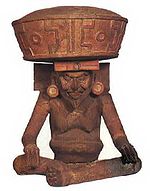Huehueteotl
Huehueteotl ( Nahuatl : old old god, the elderly god) is a Central American deity who was worshiped in various pre-Columbian cultures as the god of fire, the hearth and the north. Sometimes he is also called Ueueteotl . The Aztecs may have taken it over from the Olmecs .
Assignments, appearance, sites
In Aztec mythology , Huehueteotl's image of God overlaps with Xiuhtecuhtlis , so that both names are mentioned in different places, for example in the Codex Florentinus , as two aspects of a god: Xiuhtecuhtli-Huehueteotl. Huehueteotl, however, is typically portrayed as an old and frail man. He has a wrinkled face, a toothless mouth, and sometimes wears a brazier adorned with symbols of fire, while Xiuhtecuhtli (The Lord of Turquoise) appears powerful and youthful and has a distinctive association with domination and warrior class. Portraits of Huehueteotl have been found in archaeological digs throughout Central America. Mention should be made of an image on an incense burner in Puebla that could be dated to 500 BC. It was created 2000 years before the Aztec culture flourished. Other sites are on the Gulf of Mexico, in the north of the Yucatan peninsula , in Ticoman , Cuicuilco and in the Guatemalan highlands. Kaminaljuyú is especially worthy of mention there.
Sacrificial cult
According to Bernardino de Sahagun , the Aztecs practiced a particularly cruel sacrificial ritual to appease Huehueteotl. Prisoners of war danced with the victors in honor of the god. The next day they were taken to the platform of a pyramid where a large fire was burning. Priests tied up the prisoners, who were at least fogged by a special drug ( yauhtli ), and loaded the load on their backs. Then they danced around the fire as well and finally threw the prisoners into it. But before they died in the fire, the priests pulled them out again and tore their hearts out of their bodies. The Aztecs believed that Huehueteotl would punish Tenochtitlan with a conflagration without human sacrifice .
literature
- Karl Taube : Aztec and Mayan Myths . Phillip Reclam jun., Stuttgart (1994), ISBN 3-15-010427-0
- George C. Vaillant: The Aztecs . M. Dumont Schaumberg Publishing House, Cologne (1957)
- Eduard Seler: Some chapters from the historical work of Fray Bernardino de Sahagun . Stuttgart (1927)
- Jacques Soustelle: This is how the Aztecs lived on the eve of the Spanish conquest . German Publishing House Stuttgart, (1956)
- Mary Miller, Karl Taube: The Gods and Symbols of Ancient Mexico and the Maya: An Illustrated Dictionary of Mesoamerican Religion . Thames and Hudson, London (1993), ISBN 0-500-05068-6
Web links
- Huehueteotl at about.com
Individual evidence
- ↑ George C. Vaillant: The Aztecs , p. 45
- ^ Karl Taube: Aztec and Maya myths , p. 55
- ↑ George C. Vaillant: The Aztecs , page 53
- ^ Mary Miller, Karl Taube: The Gods and Symbols of Ancient Mexico and the Maya: An Illustrated Dictionary of Mesoamerican Religion . P. 189
- ↑ George C. Vaillant: Die Azteken , p. 201
